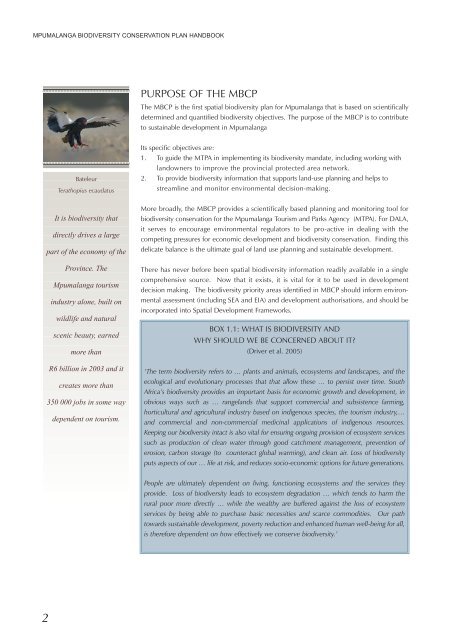Mpumalanga Biodiversity Conservation Plan Handbook - bgis-sanbi
Mpumalanga Biodiversity Conservation Plan Handbook - bgis-sanbi
Mpumalanga Biodiversity Conservation Plan Handbook - bgis-sanbi
Create successful ePaper yourself
Turn your PDF publications into a flip-book with our unique Google optimized e-Paper software.
MPUMALANGA BIODIVERSITY CONSERVATION PLAN HANDBOOK<br />
2<br />
Bateleur<br />
Terathopius ecaudatus<br />
It is biodiversity that<br />
directly drives a large<br />
part of the economy of the<br />
Province. The<br />
<strong>Mpumalanga</strong> tourism<br />
industry alone, built on<br />
wildlife and natural<br />
scenic beauty, earned<br />
more than<br />
R6 billion in 2003 and it<br />
creates more than<br />
350 000 jobs in some way<br />
dependent on tourism.<br />
PURPOSE OF THE MBCP<br />
The MBCP is the first spatial biodiversity plan for <strong>Mpumalanga</strong> that is based on scientifically<br />
determined and quantified biodiversity objectives. The purpose of the MBCP is to contribute<br />
to sustainable development in <strong>Mpumalanga</strong><br />
Its specific objectives are:<br />
1. To guide the MTPA in implementing its biodiversity mandate, including working with<br />
landowners to improve the provincial protected area network.<br />
2. To provide biodiversity information that supports land-use planning and helps to<br />
streamline and monitor environmental decision-making.<br />
More broadly, the MBCP provides a scientifically based planning and monitoring tool for<br />
biodiversity conservation for the <strong>Mpumalanga</strong> Tourism and Parks Agency (MTPA). For DALA,<br />
it serves to encourage environmental regulators to be pro-active in dealing with the<br />
competing pressures for economic development and biodiversity conservation. Finding this<br />
delicate balance is the ultimate goal of land use planning and sustainable development.<br />
There has never before been spatial biodiversity information readily available in a single<br />
comprehensive source. Now that it exists, it is vital for it to be used in development<br />
decision making. The biodiversity priority areas identified in MBCP should inform environmental<br />
assessment (including SEA and EIA) and development authorisations, and should be<br />
incorporated into Spatial Development Frameworks.<br />
BOX 1.1: WHAT IS BIODIVERSITY AND<br />
WHY SHOULD WE BE CONCERNED ABOUT IT?<br />
(Driver et al. 2005)<br />
‘The term biodiversity refers to … plants and animals, ecosystems and landscapes, and the<br />
ecological and evolutionary processes that that allow these … to persist over time. South<br />
Africa’s biodiversity provides an important basis for economic growth and development, in<br />
obvious ways such as … rangelands that support commercial and subsistence farming,<br />
horticultural and agricultural industry based on indigenous species, the tourism industry,…<br />
and commercial and non-commercial medicinal applications of indigenous resources.<br />
Keeping our biodiversity intact is also vital for ensuring ongoing provision of ecosystem services<br />
such as production of clean water through good catchment management, prevention of<br />
erosion, carbon storage (to counteract global warming), and clean air. Loss of biodiversity<br />
puts aspects of our … life at risk, and reduces socio-economic options for future generations.<br />
People are ultimately dependent on living, functioning ecosystems and the services they<br />
provide. Loss of biodiversity leads to ecosystem degradation … which tends to harm the<br />
rural poor more directly … while the wealthy are buffered against the loss of ecosystem<br />
services by being able to purchase basic necessities and scarce commodities. Our path<br />
towards sustainable development, poverty reduction and enhanced human well-being for all,<br />
is therefore dependent on how effectively we conserve biodiversity.’

















